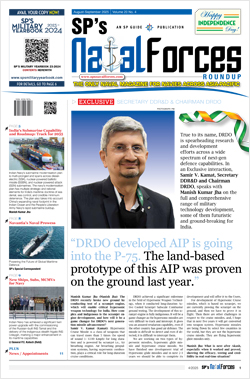INDIAN ARMED FORCES CHIEFS ON OUR RELENTLESS AND FOCUSED PUBLISHING EFFORTS

The insightful articles, inspiring narrations and analytical perspectives presented by the Editorial Team, establish an alluring connect with the reader. My compliments and best wishes to SP Guide Publications.

"Over the past 60 years, the growth of SP Guide Publications has mirrored the rising stature of Indian Navy. Its well-researched and informative magazines on Defence and Aerospace sector have served to shape an educated opinion of our military personnel, policy makers and the public alike. I wish SP's Publication team continued success, fair winds and following seas in all future endeavour!"

Since, its inception in 1964, SP Guide Publications has consistently demonstrated commitment to high-quality journalism in the aerospace and defence sectors, earning a well-deserved reputation as Asia's largest media house in this domain. I wish SP Guide Publications continued success in its pursuit of excellence.
Seminar Report
Future Geopolitics of the Indo-Pacific Region
The deliberations at the two-day “Annual Maritime Power Seminar 2013” was to imbibe a sense of the Indo-Pacific’s geopolitical posit on the world stage, its strategic compulsions and opportunities, and undertake dispassionate and rigorous analyses of issues relevant to the Indo-Pacific in the near future

The Anual Maritime Power Seminar 2013 was kick-started on February 21, 2013, at the Institute for Defence Studies and Analyses (IDSA), under the aegis of the National Maritime Foundation. The two-day seminar was “to imbibe a sense of the Indo-Pacific’s geopolitical posit on the world stage, its strategic compulsions and opportunities, and undertake dispassionate and rigorous analyses of issues relevant to the Indo-Pacific in the near future.
Chairman’s Address
In his welcome address, Admiral (Retd) Sureesh Mehta, Chairman, National Maritime Foundation, said, “For many long years, India has tended to view the Indian Ocean as a cohesive entity which drove diplomatic relations between countries on its periphery, while a fairly dominant Asia-Pacific was seen more through the eyes of regionalism. The integrated arena of the Indian Ocean and the Western Pacific, which has more recently come to be referred to as the Indo-Pacific, has become a key strategic arena in the 21st century. And it is only of late that the world has begun to see the integrated Indo-Pacific as one singular maritime theatre. The shift in the strategic centre of gravity to the East makes it necessary that we explore the emerging security imperatives in the broader Indo-Pacific region, what with the new constellation of economic and political stars such as China, Indonesia, Japan, Australia and India, appearing on the geostrategic horizon.”
While long-standing maritime boundary disputes in the South China Sea attract much media attention, disagreements over territorial waters and EEZ in the Bay of Bengal are also on the rise. India, Bangladesh and Vietnam today find themselves in the middle of such a dispute.
He focused on the China factor by saying, for some time now, there has been concern that the Indian Ocean region could witness a major military surge by China, turning it into an arena for great power competition in Asia to exploit the ‘‘string of pearls’’ —a colloquial term for Chinese-funded ports and related infrastructure along the Indian Ocean littorals—to keep Delhi off-balance. As China strengthens its ties with the Indian Ocean Rim countries, India has sought to improve its naval and security cooperation with countries of East Asia, including Singapore, Vietnam, the Philippines and Japan.
Keynote Address by CNS
In his keynote address, Chief of the Naval Staff, Admiral D.K. Joshi stated, “Today, there is a growing realisation of the centrality of the oceans in our socio-economic prosperity and recognition of India as an emerging power.”
He pointed out the fact that the term ‘Indo-Pacific’ finds increasing mention in the strategic discourse today is evidence of the growing prominence of the region as a geostrategic entity. It signifies the fusion of two geopolitically sensitive and economically vibrant regions, the shores of which are washed by the Indian and the Pacific Oceans. Given the region’s vitality, its dynamics could well define the future trajectory of political interactions of the world in the 21st century.
He cited three unrelated events which were instrumental in shaping global politics of today. The first was the break up of the Soviet Union in 1991. It brought the curtains down on the Cold War, thus causing a tectonic shift in the global strategic landscape. He attributed some of the success of globalisation, and the unprecedented economic cooperation among nations, to the new post-Cold War environment. The second event was the Gulf War of 1991, which followed the Iraqi invasion of Kuwait. The war marked a paradigm shift in the international security architecture from superpower rivalry to a new unipolar world order. The war also catalysed a revolution in military affairs, and more importantly, refocused global attention on the strategic relevance of Indian Ocean. The third event was India’s economic woes in 1991, when India had to resort to extreme contingency measures to avert a balance of payment crisis. This became instrumental in propelling India towards economic liberalisation, which, two decades down the line, is widely read as the script of India’s growth story. There have been many more, such as 9/11, which have shaped the geopolitics in profound ways.
He addressed the core issue of geopolitics of the Indo-Pacific region, which spans three major continents and is home to nearly half the world’s population. From the East Coast of Africa on the Western reaches of the Indian Ocean across Middle East, the Indian subcontinent and South- East Asia to the Far-East and Australia; the Indo-Pacific region is an amorphous mix of numerous sub-systems. Geopolitics of the Indo-Pacific is therefore an aggregate of the dynamics of its constituents, emanating from the interplay within and between these sub-systems. Vibrant economic and civilisational exchanges over thousands of years, characterises political dealings between these disparate sub-systems. Of significance is the fact that the oceans remained a common thread in their interaction due to their dependence on maritime trade.
He reiterated that the Indo-Pacific is also prone to asymmetric threats such as piracy and maritime terrorism. Piracy in and around the Strait of Malacca currently is low key, only on account of ongoing stringent measures by the concerned littorals. Piracy off Somalia is another example of the maritime consequences of instability and lawlessness on land. With volatile regions adjoining and within the Indo-Pacific, there is need to guard against such threats while managing own maritime affairs.
In conclusion, he raised the question: Are we prepared to tackle the emerging challenges, either as a nation or as part of the larger regional or global community? The current national and international laws and conventions may be inadequate to meet evolving challenges such as piracy and highjacking of merchantmen, threat of suicide attacks, misuse of shipping containers, proliferation of WMD-related material, etc. Nuclear weapons are perceived to be game-changers in geopolitics. With new states pursuing clandestine nuclear weapon programmes, global power equations could shift in future. When such changes happen across volatile and resource-rich regions, how do we manage their adverse consequences in the maritime domain? Given the vast expanse of the oceans, no state alone can ensure security of the global commons. Every state, therefore, has an obligation to contribute to maritime security, commensurate to its abilities, preferably in a cooperative framework.





